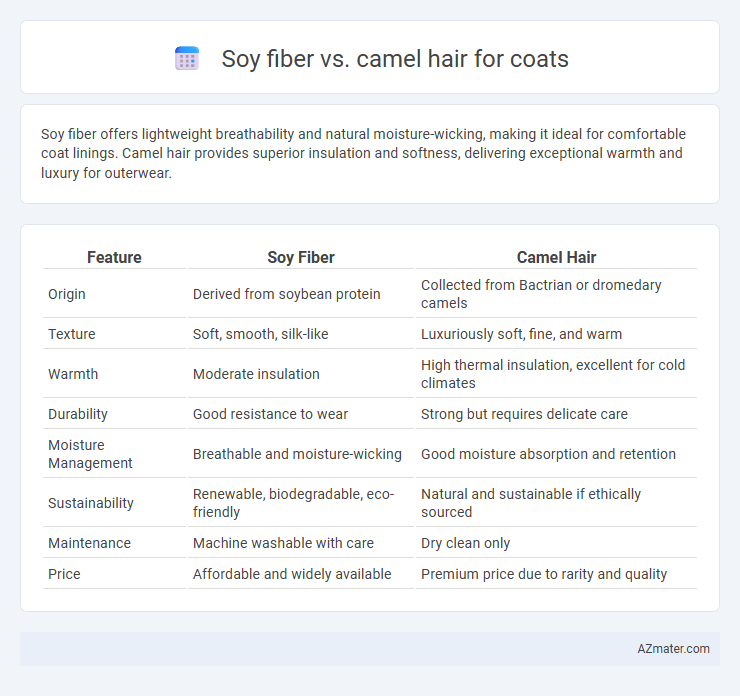Soy fiber offers lightweight breathability and natural moisture-wicking, making it ideal for comfortable coat linings. Camel hair provides superior insulation and softness, delivering exceptional warmth and luxury for outerwear.
Table of Comparison
| Feature | Soy Fiber | Camel Hair |
|---|---|---|
| Origin | Derived from soybean protein | Collected from Bactrian or dromedary camels |
| Texture | Soft, smooth, silk-like | Luxuriously soft, fine, and warm |
| Warmth | Moderate insulation | High thermal insulation, excellent for cold climates |
| Durability | Good resistance to wear | Strong but requires delicate care |
| Moisture Management | Breathable and moisture-wicking | Good moisture absorption and retention |
| Sustainability | Renewable, biodegradable, eco-friendly | Natural and sustainable if ethically sourced |
| Maintenance | Machine washable with care | Dry clean only |
| Price | Affordable and widely available | Premium price due to rarity and quality |
Introduction to Sustainable Coat Materials
Soy fiber and camel hair represent innovative and sustainable materials for coat production, combining eco-consciousness with comfort. Soy fiber, derived from soy protein, offers biodegradability and natural softness, enhancing insulation while reducing environmental impact through renewable agricultural sources. Camel hair provides exceptional warmth and durability, sourced from natural shedding without animal harm, making it an ethical choice for luxurious, sustainable outerwear.
Overview of Soy Fiber: Origins and Production
Soy fiber, derived from the byproducts of soybean processing, offers a sustainable and eco-friendly alternative for coat materials, emphasizing renewable agricultural resources. Produced through a process that extracts proteins from soybean meal, this fiber provides a soft, smooth texture with excellent moisture absorption and natural elasticity. Unlike camel hair, which comes from the undercoat of camels primarily sourced in Central Asia, soy fiber production is less dependent on animal farming, making it attractive for environmentally conscious consumers.
Camel Hair: Sourcing and Characteristics
Camel hair is sourced from the undercoat of Bactrian camels, primarily found in Mongolia and Central Asia, known for its rarity and luxury. This natural fiber boasts exceptional softness, lightweight warmth, and excellent insulation properties, making it ideal for high-quality coats. Compared to soy fiber, camel hair offers superior durability and moisture-wicking capabilities, enhancing comfort and longevity in outerwear.
Environmental Impact: Soy Fiber vs. Camel Hair
Soy fiber, derived from soybean residues, offers a sustainable alternative with low water usage and biodegradability, reducing environmental footprint compared to synthetic fibers. Camel hair, sourced naturally from camels, promotes ethical animal farming and provides excellent insulation, though its collection involves higher land use and energy consumption. Both fibers support eco-friendly fashion, but soy fiber's renewability and lower carbon emissions often result in a more environmentally conscious choice for coat production.
Warmth and Insulation Properties Compared
Soy fiber offers excellent moisture-wicking and breathability, providing moderate warmth suitable for milder climates, while camel hair excels with superior insulation due to its natural lanolin content, offering significant thermal retention in colder environments. Camel hair fibers create a lightweight yet dense barrier that traps heat effectively, outperforming soy fiber in cold weather protection. Both materials are sustainable, but camel hair is preferred for high warmth needs, whereas soy fiber suits temperature regulation and comfort in less extreme cold.
Durability and Longevity of Each Material
Soy fiber offers moderate durability and is resistant to wrinkles and abrasion, making it a practical choice for coats intended for regular, casual wear. Camel hair is renowned for its exceptional longevity, with natural resilience and insulating properties that improve with age, making it ideal for luxury outerwear designed to last many seasons. Both materials provide distinct advantages: soy fiber excels in sustainable, eco-friendly durability, while camel hair delivers premium durability and warmth over time.
Comfort and Breathability: Wearer Experience
Soy fiber coats offer exceptional breathability and moisture-wicking properties, ensuring a cool and dry wearer experience even in fluctuating temperatures. Camel hair provides natural insulation and softness, creating a warm, lightweight, and comfortable feel that adapts well to colder climates. Both fibers enhance comfort but soy fiber excels in temperature regulation, while camel hair prioritizes warmth and softness.
Style and Aesthetic Differences
Soy fiber coats offer a smooth, modern aesthetic with a subtle sheen that complements minimalist and contemporary fashion, providing lightweight warmth and a hypoallergenic appeal. Camel hair coats exude classic luxury and timeless elegance, featuring a soft, plush texture and natural tan hues that enhance traditional and sophisticated wardrobe choices. The distinct tactile qualities and color profiles of soy fiber and camel hair significantly influence their style versatility and the visual impact of outerwear designs.
Ethical Considerations and Animal Welfare
Soy fiber for coats offers a sustainable, cruelty-free alternative as it is plant-based and biodegradable, reducing environmental impact and eliminating animal welfare concerns. Camel hair, while prized for its warmth and softness, raises ethical issues since it typically involves harvesting from live animals, which can cause stress and discomfort. Consumers seeking animal-friendly and eco-conscious options increasingly prefer soy fiber, aligning with ethical fashion principles that prioritize animal welfare and sustainability.
Price and Market Availability
Soy fiber coats generally offer a more affordable price point compared to camel hair, making them a budget-friendly choice in the market. Camel hair coats are priced higher due to their luxurious texture and limited availability, which is often tied to seasonal and regional factors. Market availability of soy fiber is broader and more consistent, while camel hair remains a niche material with selective distribution in premium fashion outlets.

Infographic: Soy fiber vs Camel hair for Coat
 azmater.com
azmater.com